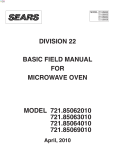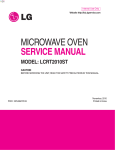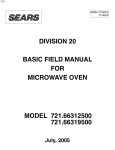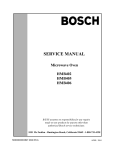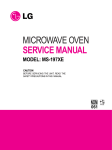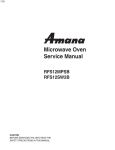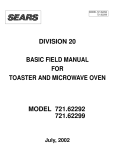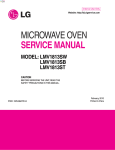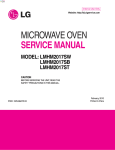Download Sears 721.66339 Specifications
Transcript
삼 정 흥 판 MODEL 721.66339 DIVISION 20 BASIC FIELD MANUAL FOR MICROWAVE OVEN MODEL 721.66339800 February, 2008 CAUTION WARNING TO SERVICE TECHNICIANS PRECAUTIONS TO BE OBSERVED BEFORE AND DURING SERVICING TO AVOID POSSIBLE EXPOSURE TO EXCESSIVE MICROWAVE ENERGY a. Do not operate or allow the oven to be operated with the door open. b. Make the following safety checks on all ovens to be serviced before activating the magnetron or other microwave source, and make repairs as necessary; (1) Interlock operation, (2) proper door closing, (3) seal and sealing surfaces (arcing, wear, and other damage), (4) damage to or loosening of hinges and latches, (5) evidence of dropping or abuse. c. Before turning on microwave for any service test or inspection within the microwave generating compartments, check the magnetron, wave guide or transmission line, and cavity for proper alignment, integrity, and connections. d. Any defective or misadjusted components in the interlock, monitor, door seal, and microwave generation and transmission systems shall be repaired adjusted by procedures described in this manual before the oven is released to the owner. e. A Microwave leakage check to verify compliance with the Federal performance standard should be performed on each oven prior to release to the owner. • Proper operation of the microwave ovens requires that the magnetron be assembled to the wave guide and cavity. Never operate the magnetron unless it is properly installed. • Be sure that the magnetron gasket is properly installed around the dome of the tube whenever installing the magnetron. • Routine service safety procedures should be exercised at all times. • Untrained personnel should not attempt service without a thorough review of the test procedures and safety information contained in this manual. -1- FOREWORD Read this Manual carefully. Failure to adhere to or observe the information in this Manual may result in exposing yourself to the Microwave Energy normally contained within the oven cavity. MODEL 721.66339 MECHANICAL SERVICE INFORMATION TABLE OF CONTENTS 1. Adjustment Procedures - - - - - - - - - - - - - - - - - - - - - - - - - - - - - - - - - - - - - - - - - - - - - - - - - - - - - - - - - - - - - - - - - - - - - - - - - - - - - - - - - - - - - - - - - - - - - - - - - - - - - - - - - - - - - - - - - - - - - - - - - - - - - - - - - - - - - - 3 2. Precautions on Installation - - - - - - - - - - - - - - - - - - - - - - - - - - - - - - - - - - - - - - - - - - - - - - - - - - - - - - - - - - - - - - - - - - - - - - - - - - - - - - - - - - - - - - - - - - - - - - - - - - - - - - - - - - - - - - - - - - - - - - - - - - - - - - - - - - 5 3. General Precautions in Use - - - - - - - - - - - - - - - - - - - - - - - - - - - - - - - - - - - - - - - - - - - - - - - - - - - - - - - - - - - - - - - - - - - - - - - - - - - - - - - - - - - - - - - - - - - - - - - - - - - - - - - - - - - - - - - - - - - - - - - - - - - - - - - - - 5 4. Trial Operation - - - - - - - - - - - - - - - - - - - - - - - - - - - - - - - - - - - - - - - - - - - - - - - - - - - - - - - - - - - - - - - - - - - - - - - - - - - - - - - - - - - - - - - - - - - - - - - - - - - - - - - - - - - - - - - - - - - - - - - - - - - - - - - - - - - - - - - - - - - - - - - - - - 5 5. Specifications - - - - - - - - - - - - - - - - - - - - - - - - - - - - - - - - - - - - - - - - - - - - - - - - - - - - - - - - - - - - - - - - - - - - - - - - - - - - - - - - - - - - - - - - - - - - - - - - - - - - - - - - - - - - - - - - - - - - - - - - - - - - - - - - - - - - - - - - - - - - - - - - - - - - 6 6. Overall Circuit Diagram - - - - - - - - - - - - - - - - - - - - - - - - - - - - - - - - - - - - - - - - - - - - - - - - - - - - - - - - - - - - - - - - - - - - - - - - - - - - - - - - - - - - - - - - - - - - - - - - - - - - - - - - - - - - - - - - - - - - - - - - - - - - - - - - - - - - 7-8 7. Operating Procedures - - - - - - - - - - - - - - - - - - - - - - - - - - - - - - - - - - - - - - - - - - - - - - - - - - - - - - - - - - - - - - - - - - - - - - - - - - - - - - - - - - - - - - - - - - - - - - - - - - - - - - - - - - - - - - - - - - - - - - - - - - - - - - - - - - - - 9-10 8. Procedure for Measuring Microwave Energy Leakage - - - - - - - - - - - - - - - - - - - - - - - - - - - - - - - - - - - - - - - - - - - - - - - - - - - - - - - - - - - - - - - - - - - - - - - - - - - - - - - - - - - - - - - 11-12 9. Disassembly Instructions - - - - - - - - - - - - - - - - - - - - - - - - - - - - - - - - - - - - - - - - - - - - - - - - - - - - - - - - - - - - - - - - - - - - - - - - - - - - - - - - - - - - - - - - - - - - - - - - - - - - - - - - - - - - - - - - - - - - - - - - - - - - - - 13-17 10. Interlock Continuity Test - - - - - - - - - - - - - - - - - - - - - - - - - - - - - - - - - - - - - - - - - - - - - - - - - - - - - - - - - - - - - - - - - - - - - - - - - - - - - - - - - - - - - - - - - - - - - - - - - - - - - - - - - - - - - - - - - - - - - - - - - - - - - - - - - - 18 11. Test and Checkout Procedures, and Troubleshooting A. Test Procedures - - - - - - - - - - - - - - - - - - - - - - - - - - - - - - - - - - - - - - - - - - - - - - - - - - - - - - - - - - - - - - - - - - - - - - - - - - - - - - - - - - - - - - - - - - - - - - - - - - - - - - - - - - - - - - - - - - - - - - - - - - - - - - - - - - - - 19-21 B. Checkout Procedures - - - - - - - - - - - - - - - - - - - - - - - - - - - - - - - - - - - - - - - - - - - - - - - - - - - - - - - - - - - - - - - - - - - - - - - - - - - - - - - - - - - - - - - - - - - - - - - - - - - - - - - - - - - - - - - - - - - - - - - - - - - - - 22-24 C. Troubleshooting - - - - - - - - - - - - - - - - - - - - - - - - - - - - - - - - - - - - - - - - - - - - - - - - - - - - - - - - - - - - - - - - - - - - - - - - - - - - - - - - - - - - - - - - - - - - - - - - - - - - - - - - - - - - - - - - - - - - - - - - - - - - - - - - - - - - - 25-29 12. Exploded view - - - - - - - - - - - - - - - - - - - - - - - - - - - - - - - - - - - - - - - - - - - - - - - - - - - - - - - - - - - - - - - - - - - - - - - - - - - - - - - - - - - - - - - - - - - - - - - - - - - - - - - - - - - - - - - - - - - - - - - - - - - - - - - - - - - - - - - - - - - 30-37 13. Part Reference list - - - - - - - - - - - - - - - - - - - - - - - - - - - - - - - - - - - - - - - - - - - - - - - - - - - - - - - - - - - - - - - - - - - - - - - - - - - - - - - - - - - - - - - - - - - - - - - - - - - - - - - - - - - - - - - - - - - - - - - - - - - - - - - - - - - - - - 38-39 -2- ADJUST THE LATCH AND SWITCH CLOSING 1. ADJUSTMENT PROCEDURES To avoid possible exposure to microwave energy leakage, adjust the door latches and interlock switches, using the following procedure. (3) Loosen the two screws holding the plastic latch board as shown. (4) With the oven door closed tightly, move the latch board upward toward the top of the oven and/or away from the door latch until the gaps are less than 1/64” (0.5 mm). ONLY AUTHORIZED SERVICE PERSONNEL SHOULD MAKE THIS ADJUSTMENT. The Interlock Monitor and Primary Interlock Switch acts as the final safety switch protecting the user from microwave energy. The terminals between “COM” and “NC” of the Interlock Monitor must close when the door is opened. After adjusting the Interlock Monitor Switch, make sure that it is correctly connected. See Figures 1-a and 1-b throughout this procedure. Hold the latch board tightly in this position until you check the sequence of the switches in steps 5 and 6. TEST THE LATCH AND SWITCH SEQUENCE (5) Open the oven door slowly. Watch the door latch, the Primary Switch. Release Rod and Lever on the switches to make sure they are zero to the body of the switches in the following sequence: CHECK THE DOOR LATCH AND SWITCH CLOSING. - Primary Interlock Switch - Secondary Interlock Switch - Interlock Monitor Switch NOTE: The outer cover of the microwave oven is removed. (1) Set the microwave oven on its side so that you can see the latch board and the switches, as shown in Figure 1-a. Adjust the latch board until the switches operate in this sequence. See Steps 3 and 4. (6) Close the oven door slowly and be sure it is tightly closed. Watch the three switches to make sure they are zero to the body of the switches in the following sequence: (2) Close the door tightly and check gaps A and B to be sure they are no more than 1/64” (0.5 mm). See Figure 1-b for close-up view of gaps A and B (door latches). If all gaps are less than 1/64” (0.5 mm), adjustment of the latch board may not be necessary. Go to Steps 5 and 6 to check the sequence of the switches. - Interlock Monitor Switch - Primary Interlock Switch - Secondary Interlock Switch NOTE: To correct sequence of the Primary Interlock Switch, Secondary Interlock Switch and the Interlock Monitor Switch is very important. NOTE: The Interlock Monitor Switch is an added safety check on the Primary and Secondary Interlock Switches. If the Primary and Secondary Interlock Switches allow the oven to operate with the door open, the Monitor Switch will blow the fuse. If any gap is larger than 1/64” (0.5 mm), you will need to adjust the latch board-U, L. Go to step 3 and follow all steps in order. (7) When you achieve the proper sequence of switches in Steps 5 and 6, tighten the latch board screws at that point. TEST THE MICROWAVE ENERGY LEAKAGE (8) Using a survey meter, make sure the microwave energy is below 5 mW/cm.sq. -3- LATCH BOARD SECONDARY INTERLOCK SWITCH DOOR LATCH A MONITOR INTERLOCK SWITCH PRIMARY INTERLOCK SWITCH DOOR LATCH Figure 1-a LATCH 0-1/64" LATCH BOARD 0-1/64" -4- Figure 1-b 2. PRECAUTIONS ON INSTALLATION 4. TRIAL OPERATION (Figure 2) A. Plug the power supply cord into a 120 V AC, 60 Hz, single-phase power source with a capacity of at least 20 amperes. B. Since the unit weights about 36.5 lbs, be sure to place it on a sturdy and flat surface. C. Avoid placing the unit in a location where there is direct heat or splashing water. D. Place the unit as far away as possible from TV, radio, etc. to prevent interference. After installation, the following sequences and results should be checked carefully. A. Put a container filled with water (about 1 liter) into the oven, and close the door tightly. B. Touch the STOP/CLEAR and the COOK TIME keys. C. Set cooking time for 10 minutes by touching “1” and then “0” three times. “1000” appears in the display window. D. Touch the START key. Make sure the cavity light comes on. The unit will begin cooking and the display window will show the time counting down by seconds. E. After about 5 minutes, make sure the primary interlock switch, the secondary interlock switch and the interlock monitor and oven lamp switch operate properly by opening and closing the door several times. Touch the START key each time the door is closed. F. Continue operating the unit. Four long beep sound signal is heard when the time is up. The unit will shut off automatically. G. Confirm the water is hot. H. Finally, measure the output power according to “POWER OUTPUT MEASUREMENT” on page 12. CAUTION This unit is equipped with a 3-prong plug for your safety. If the wall outlet is a grounded 3-hole type, the unit will be grounded automatically. Properly Polarized and Grounded Outlet Three-Pronged(Grounding) Plug Figure 2 5. FEATURES AND SPECIFICATIONS A. The safety systems incorporated in this model are: (1) Primary interlock switch (2) Secondary interlock switch (3) Interlock monitor switch (4) Choke system (5) Thermostat (Note: This thermostat located on the oven cavity will open and stop the unit from operation only if a high temperature is reached, such as, a fire created by overcooking food.) B. Any one of 10 power output levels ranging 120W to 1200W can be selected by the touch control and electronic computer system. C. Cooking time can be displayed on the digital readout. D. Three different cooking stages can be set. The oven remembers three cooking stages and changes from one cooking stage to another. This is made possible with the memory function of the microprocessor. 3. GENERAL PRECAUTIONS IN USE A. Never operate the unit when it is empty. Operating the oven with no load may shorten the life of the magnetron. Whenever cooking dry foods (dried fish, bread, etc.) or a small amount of food, be sure to put a glass of water into the cooking compartment. The turntable tray may become hot after operating, be careful when touching it. B. Aluminum foil should be avoided because it will disrupt cooking and may cause arcing. However, small pieces may be used to cover some parts of food to slow the cooking. Any aluminum foil used should never be closer than 2.5 cm to any side wall of the oven. -5- SPECIFICATIONS Rated Power Consumption ..........................................1650W maximum Output ..........................................................................1200W maximum (*IEC 60705 Rating standard) ...................................................................Adjustable 100W through 1200W, 11 steps Frequency ....................................................................2,450 MHz ± 50 MHz Power Supply ...............................................................120V ±12V AC, 60Hz Rated Current...............................................................13.8 Amp. Magnetron Cooling.......................................................Forced Air Cooling Microwave Stirring........................................................Turntable Rectification..................................................................Rectification Voltage Doubler Half-Wave Door Sealing ................................................................Choke System Safety Devices .............................................................Thermostat: Open at 90°C ± 5°C Open at 75°C ± 5°C Fuse(15A) Primary Interlock Switch Secondary Interlock Switch Interlock Monitor Magnetron ....................................................................2M246 High Voltage Capacitor ................................................Capacitor: 1.05µF, 2.1KV Ac High Voltage Diode ......................................................350mA, 9.0KV Cavity Lamp .................................................................125V, 20W Timer ............................................................................Digital, up to 99 mm. 99 sec. (in each cooking stage) Tray ..............................................................................Tempered Safety Glass Overall Dimensions ......................................................217/18”(W) x 121/2”(H) x 171/8”(D) Oven Cavity Size..........................................................1411/16”(W) x 95/8”(H) x 155/8”(D) Effective Capacity of Oven Cavity................................1.2 Cu.ft. Accessories..................................................................Use and Care Manual ,Turntable, Rotating Ring Assembly. SWITCH TABLE DOOR OPEN PRIMARY INTERLOCK SWITCH COM NO ∞ DOOR CLOSED 0 SWITCH MODE CONDITIONS NOTE: Use the above switch table with circuit diagram on page 7. -6- SECONDARY INTERLOCK SWITCH COM NO ∞ 0 INTERLOCK MONITOR SWITCH COM NC 0 ∞ -7- NOTICE: SINCE THIS IS BASIC SCHEMATIC DIAGRAM, THE VALUES OF COMPONENTS AND SOME PARTIAL CONNECTIONS ARE SUBJECT TO CHANGE FOR IMPROVEMENT. IMPORTANT SAFETY NOTE: THE SHADED AREAS ON THIS SCHEMATIC DIAGRAM INCORPORATE SPECIAL FEATURES IMPORTANT FOR PROTECTION FROM MICROWAVE RADIATION, FIRE, ELECTRICAL SHOCK, AND HAZARDS. WHEN SERVICING IT IS ESSENTIAL THAT ONLY MANUFACTURER S SPECIFIED PARTS BE USED FOR THE CRITICAL COMPONENTS IN THE SHADED AREAS OF THE SCHEMATIC DIAGRAM. 6. OVERALL CIRCUIT DIAGRAM A. SCHEMATIC DIAGRAM B. MATRIX CIRCUIT FOR TOUCH KEY BOARD Figure 4 -8- 7. OPERATING PROCEDURES A. OVEN CONTROL PANEL Figure 5 1. DISPLAY. The display includes a clock and indicators that tell you time of day, cooking time settings, and cooking functions selected. 2. QUICK TOUCH SENSOR. This pad allows you to cook most of your favorite foods without having to select cooking times and power levels. 3. MORE / LESS. All of the one touch cook and Timed Cook can be adjusted to cook food for a longer or shorter time. MORE Press MORE will add 10 seconds to the cooking time. LESS Press LESS will subtract 10 seconds to the cooking time. 4. AUTO DEFROST. This pad is an accurate defrosting method for frozen meat, poultry and fish up to 6.0 lbs. 5. TrueCookPlus®. Touch this pad to cook food according to TrueCookPlus® code. 6. NUMBER PADS. Touch Number Pads to enter cooking time, power level, quantities, or food categories. 7. COOK TIME. Touch this pad to set a cooking time. 8. STOP/CLEAR. Touch this pad to stop the oven or clear entries. 9. EXPRESS DEFROST. This pad provides you with the quick defrosting method for 1.0 pound frozen foods. 10. MELT. Touch this pad to melt chocolate, cheese, butter, or marshmallows. 11. SOFTEN. Touch this pad to soften ice cream, cream cheese, butter, or frozen juice. 12. AUTO COOK. Touch this pad to select programming food items. 13. KITCHEN TIMER. Touch this pad to use your microwave oven as a kitchen timer. 14. CLOCK. Touch this pad to enter the time of day. 15. OPTION. Touch this pad to change the oven's default settings for sound, clock, scroll speed and weight. 16. POWER. Touch this pad to set a cooking power. 17. ADD MINUTE. Touch this pad to cook at 100% cook power for 1 minute to 99 minutes and 59 seconds. 18. START. Touch this pad to start all entries (except the Quick Touch Sensor, Express Defrost, Auto Cook and Add Minute function which start automatically) and to turn Child Lock on or off. NOTE: A “beep” sounds when you touch a “key” on the control panel, to indicate that you have entered a setting. -9- (6) TIMED COOKING 1. Touch STOP/CLEAR. 2. Touch COOK TIME. 3. Touch number for cooking time. 4. Touch POWER. 5. Touch number for cooking power level. 6. Touch START. B. EASY USE TABLE (1) KITCHEN TIMER 1. Touch STOP/CLEAR. 2. Touch KITCHEN TIMER. 3. Touch correct number for time. 4. Touch START. (7) MULTI-STAGE COOKING 1. Touch STOP/CLEAR. 2. Touch COOK TIME. 3. Touch number for cooking time. 4. Touch POWER. 5. Touch number for cooking power level. 6. Repeat steps 2-5 to set 2nd cooking stage. 7. Touch START. (2) CHILD LOCK To set: 1. Touch STOP/CLEAR. 2. Touch “START” more than 4 seconds. To cancel: 1. Touch STOP/CLEAR. 2. Touch “START” more than 4 seconds. (3) SENSOR COOK 1. Touch STOP/CLEAR. 2. Touch SENSOR COOK Category. (4) ADD MINUTE 1. Touch STOP/CLEAR. 2. Touch ADD MINUTE. (5) AUTO DEFROST 1. Touch STOP/CLEAR. 2. Touch AUTO DEFROST. Three different defrosting levels are provided. (Touch 1 : Meat Touch 2 : Poultry Touch 3 : Fish) 3. Enter the weight of your food in decimal increments from 0.1 to 6.0 pounds. 4. Touch START 5. At beeping, turn food over. 6. After turning food over, touch START to resume defrosting. -10- 8. PROCEDURE FOR MEASURING MICROWAVE ENERGY LEAKAGE A. CAUTIONS (1) Be sure to check a microwave emission prior to servicing the oven if the oven is operative prior to servicing. (2) The service personnel should inform the manufacturer, importer, or assembler of any certified oven unit found to have a microwave emission level in excess of 5mW/cm.sq. and should repair any unit found to have excessive emission levels at no cost to the owner and should ascertain the cause of the excessive leakage. The service personnel should instruct the owner not to use the unit until the oven has been brought into compliance. (3) If the oven operates with the door open, the service personnel should; - Tell the user not to operate the oven - Contact the manufacturer and CDRH (Center for Devices and Radiological Health) immediately. NOTE: Address on CDRH Office of Compliance (HFZ-312) Center for Devices and Radiological Health 1390 Piccard Drive Rockville, Maryland 20850 (4) The service personnel should check all surface and vent openings for microwave emission testing. (5) Check for microwave energy leakage after every servicing. The power density of the microwave radiation leakage emitted by the microwave oven should not exceed 1mW/cm.sq. And always start measuring of an unknown field to assure safety for operating personnel from radiation leakage. NOTE: The standard is 5mW/cm.sq. while in the customer’s home. 1mW/cm.sq. stated here is manufacturer’s own voluntary standard for units in customer’s home. EQUIPMENT • Electromagnetic energy leakage monitor (NARDA 8100B, HOLADAY HI 1501) • 600cc glass beaker • Glass thermometer 100°C B. MEASURING MICROWAVE ENERGY LEAKAGE (1) Pour 275±15cc of 20±5°C water in a beaker which is graduated to 600 cc, and place the beaker in the center of the oven. (2) Set the energy leakage monitor to 2,450 MHz and use it following the manufacturer’s recommended test procedure to assure correct result. (3) When measuring the leakage, always use the 2 inch (5cm) spacer supplied with the probe. (4) Operate the oven at its maximum output. (5) Measure the microwave radiation using and electromagnetic radiation monitor by holding the probe perpendicular to the surface being measured. (See Figure 7) Move probe along shaded area. Probe scanning speed less than 2.5 cm/sec. Figure 7 C. MEASUREMENT WITH THE OUTER CASE REMOVED (1) When you replace the magnetron, measure for microwave energy leakage before the outer case is installed and after all necessary components are replaced or adjusted. Special care should be taken in measuring the following parts. - Around the magnetron - The waveguide WARNING: AVOID CONTACTING ANY HIGH VOLTAGE PARTS. Figure 6 -11- G. POWER OUTPUT MEASUREMENT (1) Fill the test beaker with 59 ˚F(15 ˚C) ~ 75 ˚F(24 ˚C) 1 liter tap water. (2) Stir the water in the beaker with thermometer ( ˚F or ˚C) and measure temperature as T1. (3) Place the beaker on the center of turntable. (4) Set for one (1) minute and three (3) seconds and operate the oven at high power. NOTE: The additional three (3) seconds is to allow the magnetron to begin generating power. (5) When the heating is finished, stir the water again with thermometer and measure the temperature of water as T2. (6) Subtract T1 from T2, this will give you the temperature rise. (7) The microwave power output is within specification, if the temperature rise is as shown below: D. MEASUREMENT WITH A FULLY ASSEMBLED OVEN (1) After all components, including the outer panels, are fully assembled, measure for microwave energy leakage around the door viewing window, the exhaust opening and air inlet openings. (2) Microwave energy leakage must not exceed the values prescribed below. NOTES: Leakage with the outer panels removed - less than 5mW/cm.sq. Leakage for a fully assembled oven (Before the latch switch (primary) is interrupted) with the door in a slightly opened position - less than 1 mW/cm .sq. E. NOTE WHEN MEASURING (1) Do not exceed meter full scale deflection. (2) The test probe must be removed no faster than 1 inch/sec (2.5cm/sec) along the shaded area, otherwise a false reading may result. (3) The test probe must be held with the grip portion of the handle. A false reading may result if the operator’s hand is between the handle and the probe. (4) When testing near a corner of the door, keep the probe perpendicular to the surface making sure the probe is moved horizontally along the oven surface. Line Voltage 120 V 108 V Temperature Rise Degrees ˚F Degrees ˚C 18.9 ~ 25.2 10.5 ~ 14 Min. 17.5 Min 9.7 (8) Power output will be influenced by line voltage of power supply. Consequently, correct power output must be measured within 120V AC ± 1 Volt while unit is operating. SPECIAL TIP • This oven used the button head screws. F. RECORD KEEPING AND NOTIFICATION AFTER MEASUREMENT (1) After adjustment and repair of any microwave energy interruption or microwave energy blocking device, record the measured values for future reference. Also enter the information on the service invoice. (2) Should the microwave energy leakage not be more than 1mW/cm.sq. after determining that all parts are in good condition, functioning properly and genuine replacement parts which are listed in this manual have been used. (3) At least once a year, have the electromagnetic energy leakage monitor checked for calibration by its manufacturer. Button Head (Torx style 2) • When you remove the screws, using the tamper-resistant Torx driver have a pin-in-head. -12- 9. DISASSEMBLY INSTRUCTIONS (6) Pull down and remove the circuit board from the control panel. (7) Remove the F.P.C connector from the terminal socket. IMPORTANT NOTES: UNIT MUST BE DISCONNECTED FROM ELECTRICAL OUTLET WHEN MAKING REPAIRS, RE-PLACEMENTS, ADJUSTMENTS AND CONTINUITY CHECKS. WAIT AT LEAST ONE MINUTE, UNTIL THE HIGH VOLTAGE CAPACITOR IN THE HIGH VOLTAGE POWER SUPPLY HAS FULLY DISCHARGED. THE CAPACITOR SHOULD BE DISCHARGED BY USING INSULATED WIRE - I.E. TEST PROBE CONNECTED TO 10KOHM RESISTOR IN SERIES TO GROUND. WHEN RECONNECTING THE WIRE LEADS TO ANY PART, MAKE SURE THE WIRING CONNECTIONS AND LEAD COLORS ARE CORRECTLY MATCHED ACCORDING TO THE OVERALL CIRCUIT DIAGRAM. (ESPECIALLY SWITCHES AND HIGH VOLTAGE CIRCUIT.) A. (1) (2) (3) (4) Remove screw ground screw securing screw REMOVING OUTSIDE CASE (Figures 8) Remove three screws from the rear section. Remove one screw from the side section. Push the outer case back about 1 inch (3cm). Lift the case from the set. Lift up and pull out control panel Figure 8 B. REMOVING POWER AND CONTROL CIRCUIT BOARD(Figure 9) (1) Open the door. (2) Remove two screws, securing the circuit board. (3) Disconnect the lead wire from RELAY(RY2) on the circuit board. (4) Lift up and pull out control panel assembly carefully from the cavity. (5) Disconnect the lead wire from connector(CN1) on the circuit board. F.P.C.Connector Circuit Board Control Panel CAUTION: DISCHARGE THE HIGH VOLTAGE CAPACITOR BEFORE SERVICING. Figures 9 -13- C. DOOR ASSEMBLY / REMOVAL (1) Open the door. (2) Remove the choke cover very carefully with a flat-blade screwdriver. CAUTION : Be careful not to damage door seal plate by screwdriver. (3) Lift up and push the door. Remove choke cover NOTE: 1. After replacing the door, be sure to check that the primary switch, monitor switch, and secondary switch operate normally. 2. After replacing the door, check for microwave energy leakage with a survey meter. Microwave energy must be below the limit of 5 mW/cm.sq. (with a 275 ml water load) 3. When mounting the door assembly to the oven assembly, be sure to adjust the door assembly parallel to the chassis. Also adjust so the door has no play between the inner door surface and oven frame assembly. If the door assembly is not mounted properly, microwaves may leak from the clearance between the door and the oven. Remove Door Figure 10 -14- D. MAGNETRON REMOVAL (1) Disconnect the wire lead from the magnetron. (2) Carefully remove the mounting screws holding the magnetron and the waveguide. (3) Remove the magnetron assembly until the tube is clear from the waveguide. E. REMOVING THE TURNTABLE MOTOR 1) Remove the turntable and rotating ring. 2) Lay the unit down on its back. 3) Remove the turntable motor cover. The turntable base cover is easily removed by pinching the eight parts with a wire cutting. 4) Disconnect the leadwire from the turntable motor terminals. 5) Remove the screw securing the turntable motor to the oven cavity ASSEMBLY. 6) After repairing the motor, rotate the removed turntable motor cover. 7) Fit the turntable motor cover’s projecting part to the base plate slit. 8) The taptite screw shall be used when a turntable motor cover is secured with a screw. NOTE: 1. When removing the magnetron, make sure its dome does not hit any adjacent parts, or it may be damaged. 2. When replacing the magnetron, be sure to install the magnetron gasket in the correct position and be sure that the gasket is in good condition. 3. After replacing the magnetron, check for microwave leakage with a survey meter around the magnetron. Microwave energy must be below the limit of 5 mW/cm2 . (With a 275 ml. water load). Make sure that gasket is rigidly attached to the magnetron. To prevent microwave leakage, tighten the mounting screws properly, making sure there is no gap between the waveguide and the magnetron. NOTE: 1. Remove the wire lead from the turntable motor VERY CAREFULLY. 2. Be sure to grasp the connector, not the wires, when removing. Air duct Magnetron Waveguide Taptite Screw Dome Waveguide Bracket Magnetron Gasket Magnetron Wire Leads Turntable Motor Figures 11 Figures 12 -15- F. HIGH VOLTAGE TRANSFORMER REMOVAL 1) Discharge the high voltage capacitor. 2) Disconnect the leadwire from magnetron, high voltage transformer, and capacitor. 3) Remove the screw holding the high voltage transformer to the baseplate. I. REMOVING SENSOR 1) Disconnect the leadwire from PCB Assembly. 2) Remove a screw securing the sensor duct. G. FAN MOTOR ASSEMBLY / REMOVAL 1) Discharge the high voltage capacitor. 2) Disconnect the leadwire from fan motor and high voltage capacitor. 3) Remove the two screws holding the the suction guide ASSEMBLY to the oven cavity. 4) Remove the two screws holding the fan motor ASSEMBLY to the suction guide ASSEMBLY. H. HIGH VOLTAGE CAPACITOR AND DIODE REMOVAL 1) Discharge the high voltage capacitor. 2) Disconnect the leadwire from fan motor and high voltage capacitor. 3) Remove the screw holding the suction guide ASSEMBLY to the oven cavity. 4) Remove the screw holding the high voltage capacitor bracket and remove the high voltage diode earth screw. Figures 14 Figures 13 -16- J. INTERLOCK SYSTEM 1) INTERLOCK MECHANISM The door lock mechanism is a device which has been specially designed to eliminate microwave activity when the door is opened during cooking and thus to prevent the danger resulting from the microwave leakage. 2) MOUNTING OF THE PRIMARY/MONITOR/ SECONDARY SWITCHES TO THE LATCH BOARD 3) INSTALLATION AND ADJUSTMENT OF THE LATCH BOARD TO THE OVEN ASSEMBLY • Mount the latch board to the oven assembly. • Adjust the latch board in the arrow direction so that oven door will not have any play in it when the door is closed. • Tighten the mounting screw. • Check for play in the door by pushing the door release button. Door movement should be less than 0.5 mm. (1/64 inch) Don't push the door release button while making this adjustment. Make sure that the latch moves smoothly after adjustment is completed and that the screws are tight. Make sure the primary, monitor, and secondary switches operate properly by following the continuity test procedure. Figures 15 -17- 10. INTERLOCK CONTINUITY TEST WARNING : FOR CONTINUED PROTECTION AGAINST EXCESSIVE RADIATION EMISSION, REPLACE ONLY WITH IDENTICAL REPLACEMENT PARTS. TYPE NO. SZM-V 16-FA-63 OR VP-533A-OF OR V-5230Q FOR PRIMARY SWITCH TYPE NO. SZM-V 16-FA-62, VP-532A-OF OR V-5220Q FOR MONITOR SWITCH TYPE NO. SZM-V 15-FA-63, VP-533A-OFF OR SECONDARY SWITCH A. PRIMARY INTERLOCK SWITCH TEST When the door release button is depressed slowly with the door closed, an audible click should be heard at the same time or successively at intervals. When the button is released slowly, the latches should activate the switches with an audible click. If the latches do not activate the switches when the door is closed, the switches should be a adjusted in accordance with the adjustment procedure. Disconnect the wire lead from the primary switch. Connect the ohmmeter leads to the common (COM) and normally open (NO) terminal of the switch. The meter should indicate an open circuit in the door open condition. When the door is closed, the meter should indicate a closed circuit. When the primary switch operation is abnormal, make the necessary adjustment or replace the switch only with the same type of switch. COMPONENTS SWITCHES (Wire leads removed) B. SECONDARY INTERLOCK SWITCH TEST Disconnect the wire lead from the secondary switch. Connect the ohmmeter leads to the common (COM) and normally open (NO) terminals of the switch. The meter should indicate a open circuit in the door open condition. When the door is closed, meter should indicate an closed circuit. When the secondary switch operation is abnormal, make the necessary adjustment or replace the switch only with the same type of switch. C. MONITOR SWITCH TEST Disconnect the wire lead from the monitor switch. Connect the ohmmeter leads to the common (COM) and normally closed (NC) terminals of the switch. The meter should indicate closed circuit in the door open condition. When the door is closed, meter should indicate an open circuit. When the monitor switch operation is abnormal, replace with the same type of switch. NOTE: After repairing the door or the interlock system, it is necessary to do this continuity test before operating the oven. TEST PROCEDURE Check for continuity of the switch with an Ohm-meter Primary Switch Monitor Switch Secondary Switch RESULTS Door open NO COM NC COM NO COM NOTE : After checking for the continuity of switches, make sure that they are connected correctly. -18- Door closed 11. TEST AND CHECKOUT PROCEDURES, AND TROUBLESHOOTING CAUTIONS 1. DISCONNECT THE POWER SUPPLY CORD FROM THE OUTLET WHENEVER REMOVING THE OUTER CASE FROM THE UNIT. PROCEED WITH THE TEST ONLY AFTER DISCHARGING THE HIGH VOLTAGE CAPACITOR AND REMOVING THE WIRE LEADS FROM THE PRIMARY WINDING OF THE HIGH VOLTAGE TRANSFORMER. 2. ALL OPERATIONAL CHECKS WITH MICROWAVE ENERGY MUST BE DONE WITH A LOAD (1 LITER OF WATER IN CONTAINER) IN THE OVEN. A. TEST PROCEDURES COMPONENTS TEST PROCEDURE RESULTS HIGH VOLTAGE TRANSFORMER (Wire leads removed) FILAMENT WINDING PRIMARY TERMINAL MAGNETRON (Wire leads removed) 1. Measure the resistance. (Ohm-meter scale: Rx1 and Rx100) • Primary winding • Secondary winding • Filament winding Approx.: 0.2 ~ 0.4 ohm Approx.: 70 ~ 100 ohm Less than: 1 ohm 2. Measure the resistance. (Ohm-meter scale: Rx1000) • Primary winding to ground • Filament winding to ground Normal: Infinite Normal: Infinite 1. Measure the resistance. (Ohm-meter scale: Rx1) • Filament terminal Normal: Less than 1 ohm 2. Measure the resistance. (Ohm-meter scale: Rx1000) • Filament to chassis Normal: Infinite -19- COMPONENTS TEST PROCEDURE RESULTS Antenna Gasket Chassis Filament NOTE: When testing the magnetron, be sure to install the magnetron gasket in the correct position and be sure that the gasket is in good condition. HIGH VOLTAGE CAPACITOR HIGH VOLTAGE DIODE NOTE : Some inexpensive meters may indicate infinite resistance in both direction. Measure the resistance. (Ohm-meter scale: Rx1000) • Terminal to terminal. Normal: Momentarily indicates several ohms, and then gradually returns to infinite. Measure the resistance. (Ohm-meter scale: Rx1000) • Terminal to case. Normal: Infinite. Measure the continuity (Forward). (Ohm-meter scale: Rx10000) Measure the continuity (Reverse). (Ohm-meter scale: Rx10000) -20- Normal: Continuity. Abnormal: Infinite. Normal: Infinite. Abnormal: Continuity. COMPONENTS RELAY 2 TEST PROCEDURE RESULTS Check for continuity of relay 2 with an ohmmeter. (Remove wire leads from relay 2 and operate the unit.) Relay 2 FAN MOTOR (Wire leads removed) POWER LEVEL 1 2 3 4 5 6 7 8 9 10 4 sec 6 sec 8 sec 10 sec 12 sec 14 sec 16 sec 18 sec 20 sec 22 sec 18 sec 16 sec 14 sec 12 sec 10 sec 8 sec 6 sec 4 sec 2 sec 0 sec Normal: A: Approx. 85 ~ 100 ohm. B: Approx. 10 ~ 25 ohm. Measure the resistance. (Ohm-meter scale: R x 1) B Abnormal: Infinite or several ohm. A TURNTABLE MOTOR (Wire leads removed) Measure the resistance. (Ohm-meter scale: R x 1) SENSOR 1) Disconnect sensor connector from micom computer board. 2) Measure resistance terminal to terminal (ohm meter scale: R X 1000) Normal: Approx.100~150 ohm Abnormal: Infinite or several ohm. Normal: Approximately BK - RD: 5.2 Kohm RD - WH: 2.1 Kohm BK - WH: 2.1 Kohm Abnormal: Infinite or several. 1 2 3 BK RD WH NOTE : • A MICROWAVE LEAKAGE TEST MUST ALWAYS BE PERFORMED WHEN THE UNIT IS SERVICED FOR ANY REASON. • MAKE SURE THE WIRE LEADS ARE IN THE CORRECT POSITION. • WHEN REMOVING THE WIRE LEADS FROM THE PARTS, BE SURE TO GRASP THE CONNECTOR, NOT THE WIRES. -21- * Sensor cooking condition 1. Oven should be plugged in at least 5 minutes before sensor cooking. 2. Room temperature should not exceed 95°F . 3. Be sure the exterior of the cooking container and the interior of the oven are dry. Wipe each off with paper towel. 4. The oven will not generate microwave energy for the first 28 seconds of the sensor cooking cycle. B. CHECKOUT PROCEDURES (1) CHECKOUT PROCEDURES FOR FUSE BLOWING CAUTION: REPLACE BLOWN FUSE WITH 20 AMPERE FUSE. PROBLEMS Fuse blows immediately after the door is closed. Fuse blows immediately after the door is opened. Fuse blows when the door is closed and START key is touched. CAUSES Improper operation of the primary interlock, secondary interlock switches and/or the interlock monitor switch. Malfunction of the high voltage transformer; the high voltage capacitor including the diode, the magnetron, the blower motor or the circuit board. NOTES: - If the fuse is blown by an improper switch operation, replace the defective switches and the fuse at the same time. After replacing the defective switches with new ones, make sure that they are correctly connected. - Check for microwave energy leakage according to “1. ADJUSTMENT PROCEDURES” on page 3, when the primary interlock, secondary interlock switches and/or the interlock monitor switches are adjusted or replaced. -22- (2) CHECKOUT PROCEDURES FOR RELAY - PROBLEM (A) FAN motor and oven lamp turn on without touching START key when the door is closed. NO GOOD YES Remove the mate connector of I/O CON from the circuit board does the unit still operate? NO Replace the circuit board - PROBLEM (B) FAN motor and oven lamp turn on When the door is closed and START key is touched. NO YES Check the interlock switches GOOD NO Replace the micro switches. YES Defective RELAY or poor connection of relay Replace RELAY or correct the connection. -23- (3) CHECKOUT PROCEDURES FOR CIRCUIT BOARD The following symptoms indicate a defective circuit board. (1) The start function fails to operate but the high voltage Systems, the interlock switches, the door sensing and the relay check good. (2) The unit with a normal relay continuously operates. (3) The buzzer does not sound or continues to sound. (4) Some segments of one or more digits do not light up, or they continue to light up, or segments light when they should not. (6) Wrong figures appear. (7) The figures of all digits flicker. (8) Some of the indicators do no light up. (9) The clock does not keep time properly. NOTE: A MICROWAVE ENERGY LEAKAGE TEST MUST ALWAYS BE PERFORMED WHEN THE UNIT IS SERVICED FOR ANY REASON. -24- C. TROUBLE SHOOTING WHEN YOU GET A COMPLAINT FROM YOUR CUSTOMER, EVALUATE THE COMPLAINT CAREFULLY. IF THE FOLLOWING SYMPTOMS APPLY, PLEASE INSTRUCT THE CUSTOMER IN THE PROPER USE OF THE MICROWAVE OVEN. THIS CAN ELIMINATE AN UNNECESSARY SERVICE CALL. CAUTIONS 1. Check grounding before checking for trouble. 2. Be careful of the high voltage circuit. 3. Discharge the high voltage capacitor. 4. When checking the continuity of the switches or of the high voltage transformer, disconnect one lead wire from these parts and then check continuity with the AC plug removed. To do otherwise may result in a false reading or damage to your meter. 5. Do not touch any part of the circuit on the PCB since static electric discharge may damage this control panel. Always touch yourself to ground while working on this panel to discharge any static charge built up in your body. (Micom model only) CONDITION CAUSE REMEDY Microwave oven does not work. Inserting many plugs into one outlet and using them at the same time. (blown fuse or breaker) Avoid using other electrical appliances when you use the microwave oven. Microwave oven plug is not inserted tightly. Insert microwave oven plug securely. Low AC input voltage. Use the microwave oven at adequate line voltage. Food temperature is too low. This may not be a defect. It is possible that the food should be cooked for a longer time period. Using metallic ware and allowing it to touch the oven wall. Do not use metallic ware for cooking except where noted in the cooking guide. Ceramic ware trimmed in gold or silver powder is used. Do not use any type of cookware with metallic trimming. Inconsistent intensity of microwave by their characteristics. 1. Use plastic wrap or lid. 2. Stir once or twice while cooking soup, cocoa or milk, etc. Output power is too low. Sparks occur. Uneven cooking. -25- (TROUBLE 1) The following visual conditions indicate a probable defective control circuit. 1. Incomplete segments. • Segment missing. • Partial segment missing. • Digit flickering (NOTE: Slight flickering is normal.) 2. Colon does not turn on or blink. 3. A distinct change in the brightness of one or more numbers in display. 4. One or more digits in the display are not lighting. 5. Display indicates a number different from one touched, for example, key in 5 and 3 appears in the display. 6. Specific numbers (for example 7 or 9) will not display when key pad is touched. 7. Display does not count down with time blinking or up with clock operation. 8. Display obviously jumps in time while counting down. 9. Display counts down too fast while cooking. 10. Each indicator light does not turn on after setting cooking cycle. 11. Display time of day does not reappear when cooking is finished. CONDITION CHECK 1. No input can be programmed. Check the connection between membrane key assembly and PCB assembly. Continuity Defective PCB assembly. Replace PCB assembly. No continuity Loose connection. Connect them tightly. Replace key membrane assembly and check operation. Everything works as specified. Defective key membrane assembly. Replace key membrane assembly. Defective PCB assembly. Replace PCB assembly. 2. Some inputs cannot be programmed. 3. Display shows a number or figure different from one touched. RESULT Still have trouble. 4. Random programming when touching other pads. 5. Display is fixed at some figure and can not accept any input. -26- CAUSE REMEDY (TROUBLE 2) Oven does not operate at all, Display window does not display any figures, and no input is accepted. CONDITION 1. Fuse blows. CHECK Check continuity of monitor switch (with door closed). RESULT CAUSE REMEDY Malfunction of the monitor switch. Replace fuse, primary, monitor switches, and RELAY(RY2) of P.C.B Assembly. Shorted contact at the primary switch. Replace fuse, primary, monitor switches, and RELAY(RY2) of P.C.B Assembly. Normal. Defective high voltage capacitor. Replace high voltage capacitor. Fuse blows again Defective high voltage transformer. Replace high voltage transformer. Defective thermostat. Replace thermostat. Defective power supply cord. Replace power supply cord. Continuity. No continuity. Replace fuse Check continuity of primary switch (with door opened). Disconnect one side of the wire lead connected from transformer to the high voltage capacitor and operate the unit. 2. Fuse does not blow. Check continuity of thermostat. Continuity. No continuity. No continuity. Continuity. Check continuity of power supply cord. No continuity. -27- (TROUBLE 3) Display shows all figures set, but oven does not start cooking while desired program times are set and START pad is touched. CONDITION CHECK 1. Setting time does not count down when touching START pad. Check continuity of secondary switch (with door closed). 2. Fan motor or oven lamp do not turn on. RESULT No continuity. CAUSE REMEDY Defective secondary switch. Replace secondary switch. Continuity. Check the connection between CN1 connector and PCB assembly. Continuity Defective PCB assembly. Replace PCB assembly. No continuity Loose connection. Connect them tightly. Check fan motor. Abnormal Defective fan motor. Replace fan motor. Check oven lamp. Abnormal Defective oven lamp. Replace oven lamp. Normal (TROUBLE 4) Oven seems to be operating but little heat is produced in oven load. CONDITION Output is low CHECK Check the power source voltage. RESULT CAUSE REMEDY Lower than 90% of rating voltage. Decrease in power source voltage with load. Suggest customer contact local electric power utility co. or qualified electrician. Defective PCB assembly. Replace PCB assembly. Defective magnetron. Replace magnetron. Normal Disconnect the wire leads from relay 2 and check on and off time with multitester. Measure the output power. Abnormal Normal Abnormal NOTE : Simple test of power output-conducted by heating one liter water for one min. if available. Minimum 8.5°C temperature rise is normal condition. -28- (TROUBLE 5) No microwave oscillation even though oven lamp and fan motor run. (Display operates properly) CONDITION No microwave oscillation. CHECK Disconnect the wire leads from relay 2 and check continuity of relay 2. (Operate the unit) Check high voltage transformer RESULT No continuity. CAUSE REMEDY Defective PCB assembly. Replace PCB assembly. Defective high voltage transformer. Replace high voltage transformer. Defective high voltage capacitor. Replace high voltage capacitor. Defective high voltage diode. Replace high voltage diode. Defective magnetron. Replace magnetron. Continuity. Abnormal Normal Check high voltage capacitor. Abnormal Normal Check high voltage diode. Abnormal Normal Check magnetron. Abnormal NOTE : • Make sure the wire leads are in the correct position. • When Removing the wire leads from the parts, be sure to grasp the connector, not the wires. • When removing the magnetron, be sure to install the magnetron gasket in the correct position and in good condition. Output is full power when you set lower power level. Disconnect the wire leads from relay 2 and check continuity relay 2. (Operate the unit) Abnormal. -29- Defective PCB assembly. Replace PCB assembly. #EV# EXPLODED VIEW INTRODUCTION SENSOR OUTER CASE INTERIOR DOOR BASE PLATE LATCH BOARD CONTROL PANEL -30- #EV# DOOR PARTS 1013 1005 1004 1002 1000 1003 1001 1006 1007 -31- #EV# CONTROLLER PARTS 2004 2381 2002 2006 W106 2000 -32- #EV# OVEN CAVITY PARTS W103 3001 3003 3034 W107 3002 3009 3008 W105 -33- #EV# LATCH BOARD PARTS W102 4001 4002 4000 4003 4002 4004 -34- #EV# INTERIOR PARTS W101 5014 5010 5001 5016 5041 3006 5012 W109 5003 W208 5007 W109 W110 W101 5000 3007 W101 5002 5015 5009 W208 W109 9000 W101 5006 -35- 5018 #EV# BASE PLATE PARTS 5008 6000 6001 6007 W101 W108 -36- #EV# SENSOR PARTS W108 W136 5011 5004 -37- P/NO: MFL30502909 Printed in Korea







































